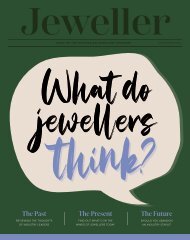Jeweller - April Issue 2018
Create successful ePaper yourself
Turn your PDF publications into a flip-book with our unique Google optimized e-Paper software.
MARKETING & PR<br />
TRENDS: MEASURE THEM OR MISS OUT<br />
IN-STORE DATA CAN SHOW RETAILERS THE NEXT EMERGING TRENDS, PROVIDING THEY KNOW WHERE TO LOOK. IT’S A SKILL<br />
THAT’S WORTH LEARNING, EVEN IF IT MIGHT SEEM LIKE A CHORE IN THE BEGINNING. DAVID BROWN REPORTS<br />
These days, business is all about big data;<br />
the industry is inundated with hordes of<br />
information that was never available to<br />
retailers from previous generations.<br />
Although this information can be invaluable<br />
for its ability to shape the decision-making<br />
process, the sheer quantity of it might<br />
overwhelm retailers.<br />
Using the information that comes from a POS<br />
system can be a helpful way of spotting the<br />
trends a business is encountering, enabling<br />
that business to react ahead of competition.<br />
The fashion industries are experts at trend<br />
spotting; top designers will spend thousands<br />
of dollars sending experts all over the world<br />
to find trends.<br />
It’s said that the fashion industry is capable<br />
of predicting what styles consumers want to<br />
wear before consumers even know it!<br />
This early insight is essential due to the<br />
constantly changing nature of their product.<br />
Although aspects of the jewellery industry’s<br />
product lines are consistent year-to-year<br />
– diamond ring designs don’t change as<br />
quickly as clothing choices – there are still<br />
trends that shape what customers like to buy<br />
and these change over time.<br />
How does trend spotting work for a business<br />
owner? The amount of information available<br />
in the average store might be surprising,<br />
especially when this information can help<br />
retailers to spot current and upcoming<br />
trends in their businesses.<br />
From sales reports to inventory-ageing<br />
and stock-imbalance statistics, there is a<br />
sumptuous array of reports that can improve<br />
a retailer’s ability to spot trends.<br />
So much information, in fact, that those<br />
retailers who aren’t spotting trends are<br />
possibly not using their data effectively.<br />
A deep curiosity is necessary for any owner<br />
who wants to play the role of trend spotter<br />
but it’s a skill that doesn’t come easily to<br />
STOREOWNERS<br />
CAN’T MANAGE<br />
WHAT THEY’RE NOT<br />
MEASURING. IT’S<br />
DIFFICULT TO SPOT<br />
TRENDS USING<br />
ONLY BAD DATA<br />
AND IMPOSSIBLE<br />
TO SPOT TRENDS<br />
WITH NO DATA<br />
DON’T OVERLOOK POSITIVE TRENDS<br />
everyone. Here are some common mistakes<br />
to be avoided to ensure the best possible<br />
chances of spotting trends early on.<br />
LACK OF A GOAL<br />
It’s one thing to look at a line on a graph<br />
and say, “Hmm, this seems to have changed<br />
course slightly.” It’s another to say, “This was<br />
expected to move toward 25 per cent and<br />
it’s only at 15 per cent.”<br />
Having an expectation makes it easier to<br />
identify when a trend has changed. This is<br />
especially important in the case of negative<br />
movements; retailers who don’t recognise<br />
these might be late to make stock changes,<br />
costing them time and money.<br />
If it’s a positive trend that is overlooked,<br />
retailers might record opportunity costs<br />
because they didn’t capitalise immediately<br />
upon emerging styles.<br />
BAD INFORMATION<br />
Storeowners can’t manage what they’re not<br />
measuring. It’s difficult to spot trends using<br />
only bad data – and impossible to spot<br />
trends with no data.<br />
Make a commitment to getting the data you<br />
need to know how the business is doing<br />
on all fronts and then create a roadmap to<br />
establish a reliable stream of information.<br />
Determine the necessary reports that<br />
will provide the business with the key<br />
information it needs.<br />
WEARING BLINKERS<br />
All retailers have different orientations to life<br />
and this reflects in the expectations they<br />
set their businesses. These expectations can<br />
create biases that affect the way retailers<br />
interpret and/or pick up on trends.<br />
What biases might you bring to the way you<br />
interpret your data? Are you an optimistic<br />
person?<br />
If so, you may want to complement that<br />
perspective with someone who has a<br />
different view so that you are looking for<br />
trends with a well-rounded perspective.<br />
After all, it’s very difficult to see that which<br />
you are not seeking.<br />
Trend spotting should be a part of every<br />
store’s employee feedback loop. Regularly<br />
collecting information from the sales team<br />
can provide valuable feedback into what<br />
customers are buying and what items no<br />
longer interest them.<br />
Combining data with anecdotal opinions<br />
from the sales floor can help businesses to<br />
stay ahead of the competition and keep<br />
product lines on trend for much longer.<br />
Retailers that can avoid the mistakes above<br />
and bring a healthy dose of curiosity to big<br />
data will be amazed by what they uncover<br />
about their businesses.<br />
Stores already have access to a mine of data<br />
that will provide owners with the answers<br />
they need. i<br />
DAVID BROWN is<br />
co-founder and business<br />
mentor of Retail Edge<br />
Consultants. Learn more:<br />
retailedgeconsultants.com<br />
<strong>April</strong> <strong>2018</strong> <strong>Jeweller</strong> 35


















